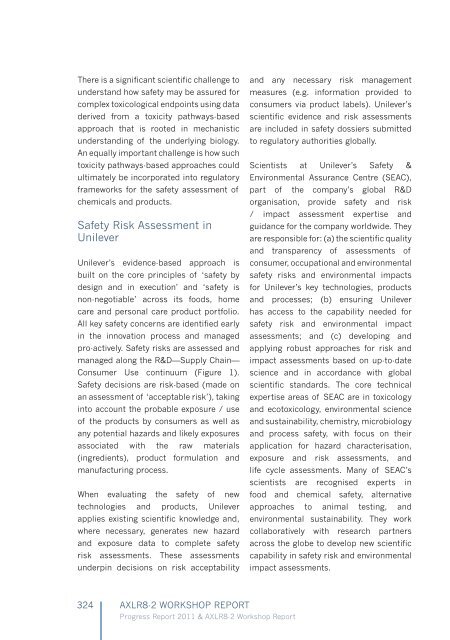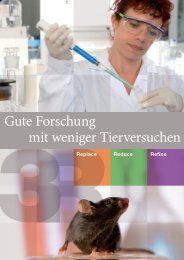Create successful ePaper yourself
Turn your PDF publications into a flip-book with our unique Google optimized e-Paper software.
There is a significant scientific challenge to<br />
understand how safety may be assured for<br />
complex toxicological endpoints using data<br />
derived from a toxicity pathways-based<br />
approach that is rooted in mechanistic<br />
understanding of the underlying biology.<br />
An equally important challenge is how such<br />
toxicity pathways-based approaches could<br />
ultimately be incorporated into regulatory<br />
frameworks for the safety assessment of<br />
chemicals and products.<br />
Safety Risk Assessment in<br />
Unilever<br />
Unilever’s evidence-based approach is<br />
built on the core principles of ‘safety by<br />
design and in execution’ and ‘safety is<br />
non-negotiable’ across its foods, home<br />
care and personal care product portfolio.<br />
All key safety concerns are identified early<br />
in the innovation process and managed<br />
pro-actively. Safety risks are assessed and<br />
managed along the R&D—Supply Chain—<br />
Consumer Use continuum (Figure 1).<br />
Safety decisions are risk-based (made on<br />
an assessment of ‘acceptable risk’), taking<br />
into account the probable exposure / use<br />
of the products by consumers as well as<br />
any potential hazards and likely exposures<br />
associated with the raw materials<br />
(ingredients), product formulation and<br />
manufacturing process.<br />
When evaluating the safety of new<br />
technologies and products, Unilever<br />
applies existing scientific knowledge and,<br />
where necessary, generates new hazard<br />
and exposure data to complete safety<br />
risk assessments. These assessments<br />
underpin decisions on risk acceptability<br />
and any necessary risk management<br />
measures (e.g. information provided to<br />
consumers via product labels). Unilever’s<br />
scientific evidence and risk assessments<br />
are included in safety dossiers submitted<br />
to regulatory authorities globally.<br />
Scientists at Unilever’s Safety &<br />
Environmental Assurance Centre (SEAC),<br />
part of the company’s global R&D<br />
organisation, provide safety and risk<br />
/ impact assessment expertise and<br />
guidance for the company worldwide. They<br />
are responsible for: (a) the scientific quality<br />
and transparency of assessments of<br />
consumer, occupational and environmental<br />
safety risks and environmental impacts<br />
for Unilever’s key technologies, products<br />
and processes; (b) ensuring Unilever<br />
has access to the capability needed for<br />
safety risk and environmental impact<br />
assessments; and (c) developing and<br />
applying robust approaches for risk and<br />
impact assessments based on up-to-date<br />
science and in accordance with global<br />
scientific standards. The core technical<br />
expertise areas of SEAC are in toxicology<br />
and ecotoxicology, environmental science<br />
and sustainability, chemistry, microbiology<br />
and process safety, with focus on their<br />
application for hazard characterisation,<br />
exposure and risk assessments, and<br />
life cycle assessments. Many of SEAC’s<br />
scientists are recognised experts in<br />
food and chemical safety, alternative<br />
approaches to animal testing, and<br />
environmental sustainability. They work<br />
collaboratively with research partners<br />
across the globe to develop new scientific<br />
capability in safety risk and environmental<br />
impact assessments.<br />
324 AXLR8-2 WORKSHOP REPORT<br />
Progress Report 2011 & AXLR8-2 Workshop Report




